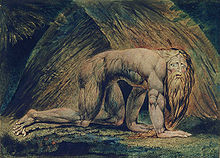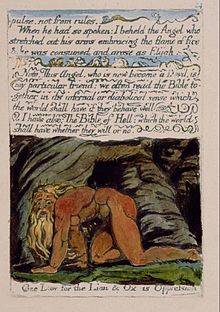- Nebuchadnezzar (Blake)
-
Nebuchadnezzar is a colour monotype print with additions in ink and watercolour portraying the Old Testament Babylonian king Nebuchadnezzar II by the English poet, painter and printmaker William Blake. Taken from the Book of Daniel, the legend of Nebuchadnezzar tells of a ruler who through hubris lost his mind and was reduced to animalistic madness[1] and eating "grass as oxen".[2]
According to the biographer Alexander Gilchrist (1828–1861), in Blake's print the viewer is faced with the "mad king crawling like a hunted beast into a den among the rocks; his tangled golden beard sweeping the ground, his nails like vultures' talons, and his wild eyes full of sullen terror. The powerful frame is losing semblance of humanity, and is bestial in its rough growth of hair, reptile in the toad-like markings and spottings of the skin, which takes on unnatural hues of green, blue, and russet."[3]
Nebuchadnezzar was part of the so-called Large Colour Prints; a series begun in 1795 of twelve 43 cm x 53 cm colour monotype prints, of most of which three copies were made. These were painted on millboard,[4] after which the board was put through Blake's printing-press with a sheet of dampened paper to make the prints. After they were printed, Blake and his wife Catherine added ink and watercolour to the impressions.[5] It existed in four impressions (copies), now in: Tate Britain in London, the Museum of Fine Arts, Boston,[6] the Minneapolis Institute of Arts,[7] and a fourth which has been missing since 1887.[8] Blake believed that Nebuchadnezzar was connected to the Christian apocalypse and to his personal view on the stages of human development.
Contents
History
Nebuchadnezzar was adapted from an earlier print in Blake's The Marriage of Heaven and Hell.[9] The plates for the Large Colour Prints and the first prints were made in 1795, but further impressions seem to have been printed in about 1805.[10] In the late summer of 1805, Blake sold to Thomas Butts Jr. eight impressions of the Large Colour Prints, including the Tate Nebuchadnezzar, for £1.1 each.[11]
John Clark Strange bought Butts's prints on 29 June 1853 and later acquired the rest of the collection that was sold to Henry George Bohn. Although he originally wanted to produce a biography on Blake, he later abandoned this idea after he learned of Gilchrist's biography. However, his journal was filled with his notes for the biography, and contain many accounts from those who knew Blake, excerpts from Blake's journal, and analysis of Blake's work.[12] In his journal, he describes Nebuchadnezzar "crawling on his belly, naked covered with hair & nails grown long, eating grass.—'What was singular was that Blake's conception was almost a facsimile of an ancient German print of the same subject and which design Blake had never seen."[13] Kenneth Clark identified the earlier image as a book illustration of a werewolf by Lucas Cranach the Elder,[14] although a closer similarity is with the small figure of the saint in Albrecht Dürer's 1496 engraving The Penance of St. John Chrysostom.[15]
-
Detail of woodcut by Lucas Cranach the Elder, 1512
Other versions
Blake had earlier depicted Nebuchadnezzar on Plate 24 of The Marriage of Heaven and Hell naked on hands and knees carrying his crown.[16] Nebuchadnezzar is represented as being in the wilderness and is, according to Samuel Palmer, similar to an older German woodcut where "almost the very same figure appears. Many years had elapsed after making his own design before Blake saw the wood cut."[17] A further depiction was added to Edward Young's Night Thoughts Volume VII.[16]
The image of Nebuchadnezzar is connected in Blake with the apocalypse in which the three people that the biblical Nebuchadnezzar burned to death were united with the Son of God,[18] and this image is also connected to Blake's belief in four states of existence in which those burned are able to transcend into the final stage of human existence.[19] Also, Nebuchadnezzar's dream of a statue represents human history from the beginning until the Apocalypse,[20] and the image of Nebuchadnezzar's rule is connected to Blake's myth of Albion in The Four Zoas.[21]
Critical response
Alexander Gilchrist, Blake's early biographer, believed that "The metallic tinting of the moss-grown crags is rendered almost as successfully as in 'Newton,' and the printing throughout the picture is well carried out, with none of the opaque oily surfaces which occur in some others of the series."[22] Dante Gabriel Rossetti commented: "Crawling on all fours in his shaggy insanity. The tawny beard trails across the left hand: the nails are literally "like birds' claws", and the flesh tints very red and "beefy." The glaring eyes, too, have almost lost their human character. The background represents a thick jungle. A fine wild conception."[23] The image inspired a passage in the poem City of Dreadful Night (1870s) by James Thomson (1834–1882):
- After a hundred steps I grew aware
- Of something crawling in the lane below;
- It seemed a wounded creature prostrate there
- That sobbed with pangs in making progress slow,
- The hind limbs stretched to push, the fore limbs then
- To drag; for it would die in its own den.
- But coming level with it I discerned
- That it had been a man; for at my tread
- It stopped in its sore travail and half-turned,
- Leaning upon its right, and raised its head,
- And with the left hand twitched back as in ire
- Long grey unreverend locks befouled with mire.
- A haggard filthy face with bloodshot eyes,
- An infamy for manhood to behold. - Canto XVIII, from line 13[24]
Notes
- ^ Myrone 2007, 82
- ^ "Nebuchadnezzar, circa 1795 / 1805". Tate. Retrieved on November 1, 2008.
- ^ Gilchrist 1998, 408–409
- ^ a type of stiff board, especially used to make book covers. description
- ^ Bentley 2003, 158–159 and Wilson, 67
- ^ MFA, Boston, Butlin 302
- ^ Minneapolis Institute of Arts, Butlin 303
- ^ Blake Archive Butlin 303
- ^ Lincoln 2003, 220
- ^ Wilson, 67
- ^ Bentley 2002, 191
- ^ Bentley 2002, 493
- ^ quoted in Bentley 2002, 496
- ^ The Early Illuminated Books. Morris Eaves, Robert N. Essick, Joseph Viscomi, David Bindman, 139, Princeton University Press, ISBN 0691001472, 9780691001470
- ^ Collins Baker, C. H. "The Sources of Blake's Pictorial Expression". 360. The Huntington Library Quarterly, Vol. 4, No. 3 (Apr., 1941), 359-367. "Blake's ... appropriation and adaptation from Durer's 'St. John Chrysostom' is well known: we can hardly doubt that the invention of his Nebuchadnezzar came about in this wise. The little crawling figure in the background of Durer's print caught his fancy, so that when he wanted an idea for Nebuchadnezzar he though, 'Why, that's the very thing; but I will show the face.' Incidentally, that alteration and an attempt to exhibit the outcast King's emanciation, deplorably overtaxed Blake's anatomical knowledge." The print is Bartsch no. 63 Image
- ^ a b Damon 1988, 297
- ^ quoted in Bentley 2002, 158
- ^ Frye, 196
- ^ Frye, 272
- ^ Frye, 252
- ^ Frye, 271
- ^ Gilchrist 1998, 409
- ^ quoted in Harper, 73
- ^ Text of the City of Dreadful Night - the figure speaks in the following passage. The link between poem and image is the subject of Harper's article. See also Maunder, 127-8
References
- Bentley, G. E. Jr. The Stranger From Paradise. New Haven: Yale University Press, 2003. ISBN 0-3001-0030-2
- Damon, S. Foster. A Blake Dictionary. Hanover: University Press of New England, 1988. ISBN 978 0 87451 436 0
- Frye, Northrop. Fearful Symmetry: A Study of William Blake. Princeton: Princeton University Press, 1990. ISBN 0691012911
- Gilchrist, Alexander. The Life of William Blake. (reprint) New York: Dover Publications, 1998. ISBN 0-486-40005-0
- Glausser, Wayne. Locke and Blake: a conversation across the eighteenth century. Miami: University Press of Florida, 1998. ISBN 0-8130-1570-7
- Harper, George M. "Blake's "Nebuchadnezzar" in "The City of Dreadful Night". Studies in Philology, Vol. 50, No. 1 (Jan., 1953), 68-80
- Lincoln, Andrew. "From America to The Four Zoas" in The Cambridge Companion to William Blake edited by Moriss Eaves, 210–230. Cambridge: Cambridge University Press, 2004. ISBN 0521786770.
- Maunder, Andrew. Grace Moore; Victorian Crime, Madness and Sensation, Ashgate Publishing, Ltd., 2004. ISBN 0-7546-4060-4
- Myrone, Martin. The Blake Book. London: Tate Gallery , 2007. ISBN 978 185437 727 2
- Raine, Kathleen. William Blake. London: Thames and Hudson. ISBN 0 500 02107 2
- Wilson, Simon; Tate Gallery, An Illustrated Companion, 1990, Tate Gallery, ISBN 854370316
Further reading
- Butlin, Martin. The Paintings and Drawings of William Blake. 2 vols. New Haven, Connecticut: Yale University Press, 1981.
William Blake Literary works Early writingsPoetical Sketches · An Island in the Moon · All Religions are One · There is No Natural ReligionSongs of InnocenceIntroduction · The Shepherd · The Ecchoing Green · The Lamb · The Little Black Boy · The Blossom · The Chimney Sweeper · The Little Boy lost · The Little Boy Found · Laughing Song · A Cradle Song · The Divine Image · Holy Thursday · Night · Spring · Nurse's Song · Infant Joy · A Dream · On Another's SorrowSongs of ExperienceIntroduction · Earth's Answer · The Clod and the Pebble · Holy Thursday · The Little Girl Lost · The Little Girl Found · The Chimney Sweeper · Nurse's Song · The Sick Rose · The Fly · The Angel · The Tyger · My Pretty Rose Tree · Ah! Sun-Flower · The Lily · The Garden of Love · The Little Vagabond · London · The Human Abstract · Infant Sorrow · A Poison Tree · A Little Boy lost · A Little Girl Lost · To Tirzah · The School Boy · The Voice of the Ancient BardOtherTiriel · The Book of Thel · The Marriage of Heaven and Hell · The French Revolution · Visions of the Daughters of Albion · The Book of Urizen · The Book of Ahania · The Book of Los · The Four Zoas · Milton a Poem · Jerusalem The Emanation of the Giant Albion ·The Auguries of Innocence · The Mental Traveller · The Crystal CabinetMythology Art Paintings and printsRelief etching · Engravings for Original Stories from Real Life · The Ancient of Days · The Night of Enitharmon's Joy · Newton · Nebuchadnezzar · Illustrations for Night Thoughts · The Four and Twenty Elders Casting their Crowns before the Divine Throne · Illustrations of Paradise Lost · A Vision of the Last Judgment · Descriptive Catalogue · The Great Red Dragon Paintings · Pity · The Ghost of a Flea · Illustrations of On the Morning of Christ's Nativity · The Wood of the Self-Murderers: The Harpies and the Suicides · Illustrations of the Book of Job · The AncientsCriticism and scholarship Scholars and criticsScholarly worksLife of William Blake · Fearful Symmetry · A Blake Dictionary: The Ideas and Symbols of William Blake · Blake: Prophet Against Empire · Witness Against the BeastWikimedia Categories:- 1795 paintings
- Collection of the Tate
- Prints (art)
- Prints with biblical themes
- Art by William Blake
-
Wikimedia Foundation. 2010.






